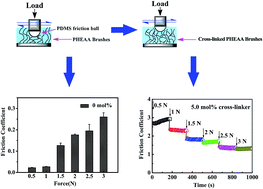Aqueous lubrication of poly(N-hydroxyethyl acrylamide) brushes: a strategy for their enhanced load bearing capacity and wear resistance
Abstract
Surface friction is a very important property for biomaterials, especially for those with implantation purposes. Recently, a new hydrophilic polymer, namely, poly(N-hydroxyethyl acrylamide) (PHEAA) has shown significant potential as biocompatible material. Herein, the surface friction of PHEAA brushes was studied. First, PHEAA brushes with well-controlled thickness were prepared via surface-initiated atomic transfer radical polymerization (SI-ATRP). Then, the surface friction coefficients of these brushes in water were measured aiming to better understand the thickness dependence of the surface lubrication properties. The results showed that the surface lubrication of PHEAA brushes highly depends on surface morphology and hydration state. With an optimal polymer film thickness of ∼21.5 nm, PHEAA-grafted surfaces show an ultralow friction coefficient of ∼0.013. To enhance the load bearing and wear resistance of the surface lubrication, a strategy of cross-linking was proposed. Cross-linked gel brushes were prepared by adding cross-linker N,N′-methylene bis(acrylamide) during the SI-ATRP. It was shown that the presence of a cross-linker in the ATRP resulted in high surface roughness, leading to a significant increment of surface friction to ∼2, albeit the water contact angle was lower. However, the strategy of cross-linking showed great success in enhancing the load bearing and wear resistance of polymer brushes. Differing from uncross-linked polymer brushes, cross-linked gel brushes showed decreased friction coefficients when increasing the compression load. Moreover, the wear resistance of the polymer brushes was also improved, as evidenced by the fact that the friction coefficient of cross-linked gel brushes was stable at 2000 s, while the friction coefficient of uncross-linked brushes increased quickly (at ∼700 s).


 Please wait while we load your content...
Please wait while we load your content...